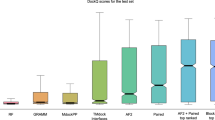Abstract
THE variation of ion-pair association constants, KA, with change in solvent is generally summarized as a plot of log KA against the reciprocal of the solvent permittivity, ε, thereby testing the success of theoretical treatments of ion association1. Generally, agreement between theory and experiment is qualitative rather than quantitative. For example2, in a plot of this sort for lithium iodide in mixtures of dioxan and water, the curve has two essentially linear portions covering the range 44.47 ⩾ ε > 19.13 (that is, 102 Δε−1 = 2.9787) and 12.03 ⩾ ε > 4.00 (that is, 102Δε−1=17.6874). Even in the event of the plot being a straight line, the molecular significance of the trends in association constant with bulk permittivity are not obvious. For this reason, other correlations must be sought. One such possibility is the relation between log KA and the mean molecular weight of the solvent. For relations of this sort, comparison between the properties of solutes in various solvents is facilitated by converting derived parameters, for example, association constants expressed in molarities, KA(C), to corresponding thermodynamic parameters using mole fraction concentration units2, such as KA(x) (assuming densities at 80, 87, 91 and 95 wt per cent dioxan in water are equal). Thus this removes the cratic contributions leaving the required unitary quantities3. In Fig. 1 comparison is made between plots of log KA against both ε−1 and the mean molecular weight, M̄, for lithium iodide in dioxan–water mixtures at 25° C. The correlation with solvent molecular weight is at least as good as that with permittivity and is perhaps preferable since the permittivity is also some function of solvent composition. Correlation between a derived quantity, for example KA, with a continuum function begs the question of how the latter is related to solvent composition.
This is a preview of subscription content, access via your institution
Access options
Subscribe to this journal
Receive 51 print issues and online access
$199.00 per year
only $3.90 per issue
Buy this article
- Purchase on Springer Link
- Instant access to full article PDF
Prices may be subject to local taxes which are calculated during checkout
Similar content being viewed by others
References
Fuoss, R. M., J. Amer. Chem. Soc., 80, 5059 (1958).
Atkinson, G., and Mori, Y., J. Chem. Physics, 45, 4716 (1966).
Gurney, R. W., Ionic Processes in Solution (McGraw-Hill, London, 1953).
Author information
Authors and Affiliations
Rights and permissions
About this article
Cite this article
BLANDAMER, M. Ion Pair Association Constants and Solvent Composition. Nature 214, 380–381 (1967). https://doi.org/10.1038/214380a0
Received:
Issue Date:
DOI: https://doi.org/10.1038/214380a0
Comments
By submitting a comment you agree to abide by our Terms and Community Guidelines. If you find something abusive or that does not comply with our terms or guidelines please flag it as inappropriate.



